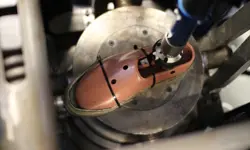
Improving access to the gold standard of MRI scanning
MRI scanners use strong magnetic fields and radio waves to produce detailed images of the inside of the body. They can be used to examine almost any part of the body, and the stronger the magnetic field, the higher the resolution of images that are produced. The first MRI scanners, developed in the 1970s, had a magnetic field strength of well under 1.0 Tesla. Today, most MRI scanners operate at 1.5 to 3.0 Tesla, and have become an invaluable diagnostic tool, used to help millions of patients around the world.
With double the field strength of most MRI scanners, SMT’s magnet enables much higher resolution images. The ultra-high magnetic field (UHF) 7 Tesla (7T) system offers sharp enough images to show vascularity of the brain without the pigment that is usually required for contrast. This allows researchers to identify lesions and bleeds, and specific areas of the body affected, more easily, potentially enabling unprecedented insights into hard-to-diagnose conditions.
Innovation
Achieving such a leap forward in magnetic field was a huge engineering challenge. A MRI magnet is composed of a number of coils of thin wires carrying a high current. The move from 3T to 7T required the addition of enough wire to stretch between London and Brussels. These coils then need to be cooled to 4.2 Kelvin to enable the wire to become superconducting and carry enough current to generate a magnetic field 140,000 times that of the Earth’s own. The magnet is vacuum insulated, like a thermos flask, in order to maintain the large temperature gradient between ambient conditions and -269ºC around the inner magnet coils.
The move from 3T to 7T required the addition of enough wire to stretch between London and Brussels
SMT’s system is half the weight of other current technologies and is preassembled and cooled at the factory ready for air freighting, unlike conventional ultra-high field MRI scanners, which have to be shipped in parts and assembled and cooled in situ. This saves several weeks and also cuts the helium requirement, a key advantage given the global helium shortage. The 7T magnet has now been incorporated into the MAGNETOM Terra system, which will offer clinicians and researchers access to the best of MRI imaging.
the team completely re-invented the superconducting magnet, creating a smaller, lighter, better integrated structure
SMT, which employs 420 people at its Oxfordshire site, was able to achieve this remarkable step-change in MRI capability by starting from scratch rather than making incremental improvements to their existing technologies. By investing heavily in R&D, and probing the absolute physical limits of the technology, the team completely re-invented the superconducting magnet, creating a smaller, lighter, better integrated structure.
Benefit to society
The MAGNETOM Terra will enable new insights into neuro-degenerative diseases, such as Alzheimer’s, Parkinson’s and multiple sclerosis, which represent some of the largest unmet challenges within medicine today. It could also assist in drug development through improved pre-screening of clinical trial participants to ensure that their conditions are similar, enabling more efficient drug trials. There is the possibility it could be used to help develop treatments for early-stage diseases and enable monitoring of the efficacy of existing treatments, detecting, for example, whether chemotherapy drugs have penetrated a cancerous tumour.
For more information, visit siemens magnet technology
***
This article has been adapted from "Improving access to the gold standard of MRI scanning, Siemens Magnet Technology", which originally appeared in the print edition of Ingenia 67 (June 2016).
Keep up-to-date with Ingenia for free
SubscribeRelated content
Health & medical

A gamechanger in retinal scanning
2006 MacRobert Award winner Optos rapidly became a leading medical technology company and its scanners have taken millions of retinal images worldwide. There is even a display at the Science Museum featuring the Optos development. Alastair Atkinson, of the award-winning team, describes the personal tragedy that was the trigger for the creation of Optos.

Kidney dialysis
Small haemodialysis machines have been developed that will allow more people to treat themselves at home. The SC+ system that has been developed is lighter, smaller and easier to use than existing machines.

Engineering polymath wins major award
The 2015 Queen Elizabeth Prize for Engineering has been awarded to the ground-breaking chemical engineer Dr Robert Langer FREng for his revolutionary advances and leadership in engineering at the interface between chemistry and medicine.

Blast mitigation and injury treatment
The Royal British Legion Centre for Blast Injury Studies is a world-renowned research facility based at Imperial College London. Its director, Professor Anthony Bull FREng, explains how a multidisciplinary team is helping protect, treat and rehabilitate people who are exposed to explosive forces.
Other content from Ingenia
Quick read

- Environment & sustainability
- Opinion
A young engineer’s perspective on the good, the bad and the ugly of COP27

- Environment & sustainability
- Issue 95
How do we pay for net zero technologies?
Quick read

- Transport
- Mechanical
- How I got here
Electrifying trains and STEMAZING outreach

- Civil & structural
- Environment & sustainability
- Issue 95